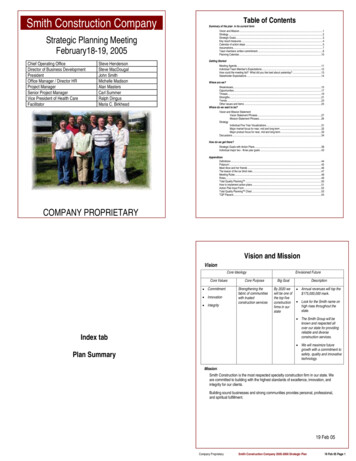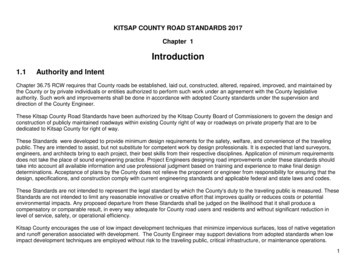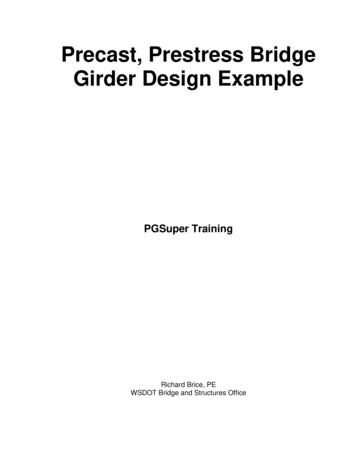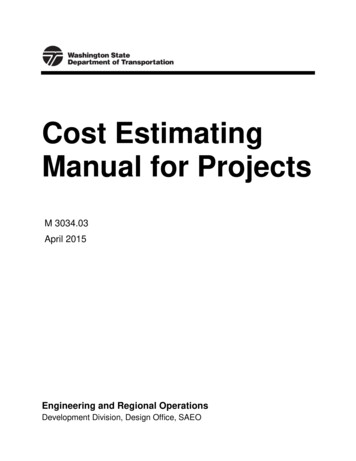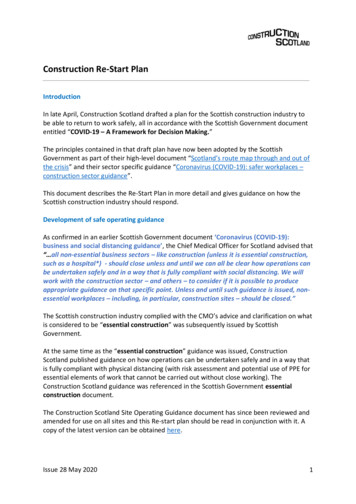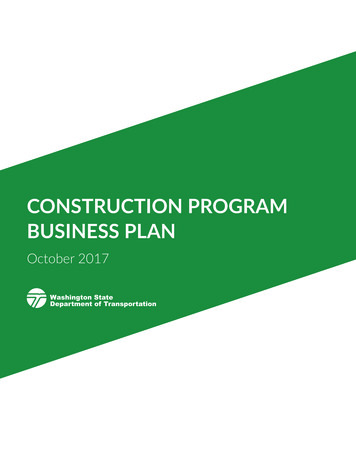
Transcription
CONSTRUCTION PROGRAMBUSINESS PLANOctober 2017
CONTENTSEXECUTIVE SUMMARY. 1Goal 1: Strong owner and stewardship. 2Goal 2: Sustainable staffing levels. 3Goal 3: Project delivery. 3Next steps. 3CHAPTER 1. 4About the Construction Program Business Plan. 4JTC Design-Build Implementation Study. 41.1 Planning process. 5CHAPTER 2. 6The landscape for capital program delivery. 62.1 Managing staffing levels. 72.2 Supporting workforce needs. 132.3 Anticipating future project delivery. 21CHAPTER 3 . 24Construction Program Business Plan goals and strategies . 24CHAPTER 4. 33Work plan. 33CHAPTER 5. 34Next steps. 34APPENDIX. 35
Message from the Secretary of TransportationAs our state invests billions of dollars into critical transportation improvements over thenext 16 years, the Construction Program Business Plan is designed to guide effectiveproject delivery in a changing construction landscape.Central to these changes is the Washington State Department of Transportation’sdesire to improve our delivery of construction projects by finding opportunities to takefull advantage of the design-build method and use of consultants. This delivery effortis designed to maximize efficiencies, and will allow WSDOT to be a better steward ofstate dollars and deliver projects faster. The focus on design-build also has importantimplications not only for how we carry out projects, but also how we forecast staffing levelsand anticipate workforce development needs.The Legislature directed WSDOT to develop this plan through the Connecting Washingtonrevenue package via Second Engrossed Substitute Senate Bill 5997 in 2015. Throughoutthe plan development, we relied heavily on ideas from a Stakeholder Advisory Committeeled by representatives from the Professional and Technical Employees Local 17, AmericanCouncil of Engineering Companies of Washington, Associated General Contractors ofWashington, and WSDOT’s engineering staff.The Plan outlines goals and associated strategies for delivering a successful multi-yearconstruction program. The goals include: Retaining a strong owner role, which involves partnerships with industry andaddressing employee recruitment, training, career development, retention, andcompetitive compensation. Ensuring sustainable staffing levels for state-employed engineering staff, includingprojections updated each biennium to support our capital improvement andpreservation program. Incorporating recommendations from the Joint Transportation Committee’s 2016design-build study into future project delivery.We are entering a challenging and exciting new era of transportation investments that aresure to transform the way that residents, businesses, and visitors move around our state.I invite you to review the Construction Program Business Plan and learn more about ourframework for building the future of our state.Best,Roger M. Millar, PE, AICPSecretary of Transportationi
Message from the Stakeholder Advisory CommitteeWashington state residents and businesses depend on a safe, reliable, and efficient publictransportation system. WSDOT is the steward of that system, repairing roads and highwayfacilities, building capacity, and designing systems to improve the way we travel.As partners with WSDOT, we believe it is in all our interests that WSDOT remain a strong,capable steward of the transportation system. Through our participation in the Plandevelopment, we found WSDOT faces multiple challenges: Establishing a sustainable staffing level to avoid attrition of experiencedengineering staff. The rapid upsizing and downsizing of staff to support deliveryof the last two transportation funding packages—the 2003 Nickel and 2005Transportation Partnership Programs—resulted in WSDOT losing well-trained seniorengineering staff. It also resulted in an exodus of mid-level engineers, who left theagency for jobs that promised more stability. Retaining and recruiting a strong talent pool in a strong job market. Investing inrecruiting and retaining a strong talent pool benefits WSDOT, taxpayers, and industrypartners. High-quality staff provide competent, decisive leadership that leads tobetter productivity and more successful contracting relationships. However, WSDOTfaces a competitive job market for engineers, especially within the Puget Soundcorridor. Addressing the gap in salary levels for WSDOT engineers compared to bothpublic and private sector positions in Washington state. Salary levels for WSDOTengineers are ranked at or near the bottom of the comparison group at every payjuncture, jeopardizing WSDOT’s ability to recruit and retain skilled staff. The payincrease passed in the 2017 Legislative Session will help minimize the gap for someengineering positions, but does not address salaries at the management level.Compounding the problem, the State of Washington does not have a mechanismto address pay increases until WSDOT can demonstrate there is an issue withrecruitment and retention after experienced staff have already left the agency. This istoo late in the dynamic process of delivering transportation projects. Providing effective training for WSDOT staff to effectively deliver the constructionprogram. A greater number of future WSDOT contracts will use the design-buildcontracting method, adding complexity. WSDOT staff will need additional skills andtraining to provide effective oversight of these projects.Given these challenges, these are our top four priorities for this Plan:1. WSDOT must continue to take action to prevent significant staffing fluctuations andprovide more predictability to staff and industry.2. It is essential for WSDOT to invest in recruiting and retaining a strong talent pool toprovide predictability for industry and stability for staff.3. The state of Washington should create and implement a proactive strategy forproviding competitive salaries for WSDOT’s engineering and technical workforce.4. WSDOT must invest in expanding its training and professional development program.
The Plan that follows this letter fully addresses these priorities. This partnership approachto developing this Plan represents a sea change in how WSDOT and partners worktogether—by finding common solutions, rather than asserting our priorities as individualorganizations. It is our intent that this collaboration continues as WSDOT implements theplan and we measure our progress.We believe it is in the best interest of the public and industry that WSDOT moves forwardquickly to implement the Construction Program Business Plan. We lend our full support tothe Plan and look forward to continuing to advise WSDOT as it is enacted over the comingyears.Sincerely,Van CollinsAmerican Council ofEngineering Companies ofWashington (ACEC)Tyler KimberleyAssociated GeneralContractors (AGC)of WashingtonVince OliveriProfessional and TechnicalEmployees Local 17
Executive SummaryEXECUTIVE SUMMARYThe Washington State Department of Transportation developed the Construction Program Business Plan (the Plan) to guidehow the agency will continue to improve delivery of transportation projects. In response to direction from the Legislature, thePlan outlines how WSDOT will strike a balance between sustainable staffing levels of engineering, technical employees, andconsultants. The Plan also addresses how WSDOT will continue to provide a high-quality workforce to deliver billions of dollars oftransportation programs and projects funded by Connecting Washington, while fully developing design-build.In 2015, the Legislature passed Second Engrossed Substitute Senate Bill 5997, directing the Joint Transportation Committee (JTC)to review WSDOT’s implementation of design-build. The bill further directed WSDOT to develop the Plan in coordination with aStakeholder Advisory Committee, made up of representatives from the Professional and Technical Employees Local 17, AmericanCouncil of Engineering Companies of Washington (ACEC), Associated General Contractors (AGC) of Washington, and WSDOT.After the JTC completed its design-build recommendations in December 2016, WSDOT convened the Stakeholder AdvisoryCommittee in January 2017 and collaborated over six months to develop this Construction Program Business Plan. The StakeholderAdvisory Committee was charged with defining key elements of WSDOT’s strong owner strategy related to recruitment, training,retention, and competitive compensation while also outlining sustainable staffing levels and reporting on how WSDOT is addressingthe results of JTC’s study.The committee’s recommendations were informed by and help respond to the findings in the following studies: JTC’s Review of Washington State Department of Transportation’s Implementation of Design-Build Project Delivery:JTC identified recommendations for WSDOT to maximize efficiencies in cost and schedule by effectively employing design-build. WSDOT’s Recruitment and Retention Study: this study outlined challenges and recommended how to strengthen theagency’s recruitment and retention of the engineering and technical workforce.As a first step, the committee reviewed and discussed data to understand WSDOT’s past and future needs related to managingstaffing levels, supporting the capital improvement and preservation program workforce, and future project delivery. Informed bythese findings, the Stakeholder Advisory Committee is proposing the following goals for WSDOT’s future construction program andstrategies to adopt them. Goal 1: Strong owner and stewardshipWSDOT continues to be a good steward of the state transportation infrastructure by strengthening the agency’s role as astrong owner. Goal 2: Sustainable staffingWSDOT will ensure the agency has the right balance of staff and consultants it needs to deliver a successful and efficientcapital improvement and preservation program by addressing staffing needs In a productive, sustainable, and predictable way. Goal 3: Project deliveryEnact and accomplish the majority of recommendations of the Joint Transportation Committee’s design-build study.1
Executive Summary(Executive Summary continued)What does WSDOT mean by “strong owner?”The State of Washington represents taxpayers by taking care of public lands and infrastructure. In this role, the State ofWashington assigns responsibility to WSDOT to facilitate safe and efficient movement of people and goods. WSDOTmaintains the state’s role as a strong owner by: Serving as a steward of Washington’s state-ownedmultimodal transportation system. Providing quality staff who are capable and knowledgeableabout building, maintaining, and operating the state’stransportation system. Providing solutions and performance through effectivebudget and schedule control on capital improvement andpreservation projects. Recognizing and embracing flexibility and alternative ideaswithin industry. Taking thoughtful, nimble, and decisive actions, guided bystate and taxpayer interests.Goal 1: Strong owner and stewardshipGoalStrategiesWithin the framework ofthe capital improvementand preservation program,WSDOT will advance thestrong owner role throughthese strategies focusedon workforce developmentand partnerships. WSDOT continues to be a good steward of the state transportation infrastructure by maintainingand strengthening the agency’s role as a strong owner. Achieve buy-in into the strong owner approach from staff, industry, and the Legislature bydeveloping and implementing a communication and outreach plan for WSDOT’s ExecutiveLeadership. Provide a strong, capable, and high-quality engineering workforce by developing and managing aworkforce development plan. Maintain the trust of the taxpayers, t
next 16 years, the Construction Program Business Plan is designed to guide effective project delivery in a changing construction landscape. Central to these
